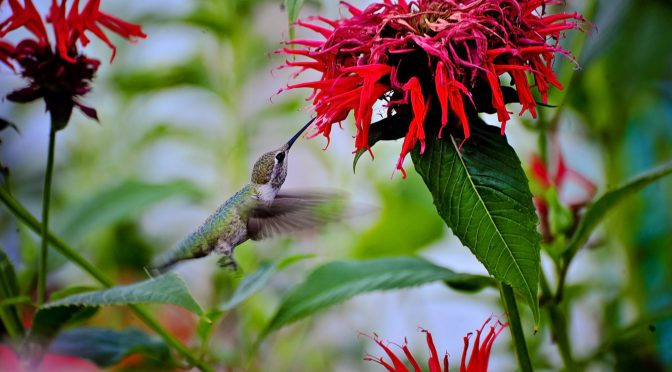In the past we’ve discussed the basics of pollinator gardens, planting for Black Swallowtail Butterflies, and 5 butterflies common to the Mid-Atlantic and how to support them. We’ve also covered 10 beneficial birds and how to attract them. However, a Facebook follower recently pointed out we haven’t done a post about hummingbirds! So without further adieu, here’s what you should know about planting for hummingbirds.
Hummingbird Species
If you live in the Eastern U.S., the hummingbirds you see are likely to be Ruby-throated Hummingbirds. Occasionally, Black-chinned Hummingbirds and Rufous Hummingbirds are seen during the winter, primarily in the Deep South.
A great resource for bird lovers is The Cornell Lab of Ornithology Macaulay Library. You can find photos, videos, and audio recordings of birds from all over.
Habitat and Diet
Hummingbirds spend a lot of their time in open woodlands but they’re easily tempted into yards and gardens with flowers and feeders. You can make your garden and yard more appealing by avoiding large, open areas. Birds prefer to have shelter in the form of clusters of trees, shrubs, or even vines on harbors. They also prefer a varied garden. Opt for plants in a variety of heights. Hummingbirds migrate to Mexico and South America each winter.
Hummingbirds are pollinators and are known for their habit of eating nectar and sap. They may also help keep pests down in your garden too. Hummingbirds are omnivores and sometimes feed on small insects and spiders. They need to eat about twice their body weight per day due to their high metabolism which helps them sustain their rapid wing beats. Check out this bird feeder that spins squirrels to avoid them from stealing their food.
Keeping your lawn and garden free of chemicals like insecticides helps keep hummingbirds and other important wildlife healthy.
Flowers
Hummingbirds tend to have a preference for long, tubular flowers that hold a lot of nectar. They also rely heavily on sight to find flowers so those that are brightly colored are excellent choices. It should be noted that though they love the color red you shouldn’t buy or make red “hummingbird food.” Red dyes and food coloring are harmful to hummingbirds.
Here are a few great choices:
- Anise-Hyssop
- Bee Balm (Monarda)
- Butterfly Weed
- Cardinal Flower
- Four O’ Clocks
- Foxglove
- Hibiscus (Roselle)
- Hollyhock
- Hostas
- Lupine
- Nicotiana (Flowering Tobacco)
- Petunia
- Phlox
- Salvia
- Soapwort
They’ll also visit flowering shrubs, vines, and trees like Honeysuckle, Cardinal Vine, Rhododendron, and Butterfly Bush.
Having flowers available in the fall can be especially helpful as hummingbirds prepare to migrate. They sometimes double their weight in preparation for their long flight south! Take a look at blooming times and opt for long-blooming varieties or experiment with multiple successions of annuals.

